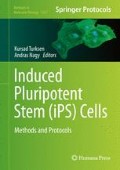Abstract
Human induced pluripotent stem (hiPS) cells are very attractive tools for modeling diseases and regenerative medicine. However, to achieve them, the efficient differentiation methods of hiPS cells into aimed cell type in vitro are necessary. Because mesoderm cells are useful in particular, we have developed the differentiation of mouse embryonic stem (mES) cells into mesoderm cells previously. In this time, these methods were improved for hiPS cells and now human mesoderm cells are able to be obtained efficiently. It is certain that the new methods are applicable to various studies and therapies.
Access this chapter
Tax calculation will be finalised at checkout
Purchases are for personal use only
References
Takahashi K, Tanabe K, Ohnuki M, Narita M, Ichisaka T, Tomoda K, Yamanaka S (2007) Induction of pluripotent stem cells from adult human fibroblasts by defined factors. Cell 131:861–872
Kitagawa M, Takebe A, Ono Y, Imai T, Nakao K, Nishikawa S, Era T (2012) Phf14, a novel regulator of mesenchyme growth via platelet-derived growth factor (PDGF) receptor-α. J Biol Chem 287:27983–27996
Hamasaki M, Hashizume Y, Yamada Y, Katayama T, Hohjoh H, Fusaki N, Nakashima Y, Furuya H, Haga N, Takami Y, Era T (2012) Pathogenic mutation of ALK2 inhibits induced pluripotent stem cell reprogramming and maintenance: mechanisms of reprogramming and strategy for drug identification. Stem Cells 30:2437–2449
Keller G (2005) Embryonic stem cell differentiation: emergence of a new era in biology and medicine. Genes Dev 19:1129–1155
Tada S, Era T, Furusawa C, Sakurai H, Nishikawa S, Kinoshita M, Nakao K, Chiba T, Nishikawa S-I (2005) Characterization of mesendoderm: a diverging point of the definitive endoderm and mesoderm in embryonic stem cell differentiation culture. Development 132:4363–4374
Kabrun N, Buhring HJ, Choi K, Ullrich A, Risau W, Keller G (1997) Flk-1 expression defines a population of early embryonic hematopoietic precursors. Development 124:2039–2048
Nishikawa SI, Nishikawa S, Hirashima M, Matsuyoshi N, Kodama H (1998) Progressive lineage analysis by cell sorting and culture identifies FLK1 + VE-cadherin + cells at a diverging point of endothelial and hemopoietic lineages. Development 125:1747–1757
Yamashita J, Itoh H, Hirashima M, Ogawa M, Nishikawa S, Yurugi T, Naito M, Nakao K, Nishikawa S (2000) Flk1-positive cells derived from embryonic stem cells serve as vascular progenitors. Nature 408:92–96
Soriano P (1997) The PDGF alpha receptor is required for neural crest cell development and for normal patterning of the somites. Development 124:2691–2700
Kataoka H, Takakura N, Nishikawa S, Tsuchida K, Kodama H, Kunisada T, Risau W, Kita T, Nishikawa SI (1997) Expressions of PDGF receptor alpha, c-Kit and Flk1 genes clustering in mouse chromosome 5 define distinct subsets of nascent mesodermal cells. Dev Growth Differ 39:729–740
Takebe A, Era T, Okada M, Jakt LM, Kuroda Y, Nishikawa S-I (2006) Microarray analysis of PDGFR alpha + populations in ES cell differentiation culture identifies genes involved in differentiation of mesoderm and mesenchyme including ARID3b that is essential for development of embryonic mesenchymal cells. Dev Biol 293:25–37
Sakurai H, Era T, Jakt LM, Okada M, Nakai S, Nishikawa S, Nishikawa S-I (2006) In vitro modeling of paraxial and lateral mesoderm differentiation reveals early reversibility. Stem Cells 24:575–586
Lian Q, Lye E, Suan Yeo K, Khia Way Tan E, Salto-Tellez M, Liu TM, Palanisamy N, El Oakley RM, Lee EH, Lim B, Lim SK (2007) Derivation of clinically compliant MSCs from CD105+, CD24− differentiated human ESCs. Stem Cells 25:425–436
Barberi T, Willis LM, Socci ND, Studer L (2005) Derivation of multipotent mesenchymal precursors from human embryonic stem cells. PLoS Med 2:e161
Xu C, Jiang J, Sottile V, McWhir J, Lebkowski J, Carpenter MK (2004) Immortalized fibroblast-like cells derived from human embryonic stem cells support undifferentiated cell growth. Stem Cells 22:972–980
Stojkovic P, Lako M, Stewart R, Przyborski S, Armstrong L, Evans J, Murdoch A, Strachan T, Stojkovic M (2005) An autogeneic feeder cell system that efficiently supports growth of undifferentiated human embryonic stem cells. Stem Cells 23:306–314
Li F, Bronson S, Niyibizi C (2010) Derivation of murine induced pluripotent stem cells (iPS) and assessment of their differentiation toward osteogenic lineage. J Cell Biochem 109:643–652
Lian Q, Zhang Y, Zhang J, Zhang HK, Wu X, Zhang Y, Lam FF, Kang S, Xia JC, Lai WH, Au KW, Chow YY, Siu CW, Lee CN, Tse HF (2010) Functional mesenchymal stem cells derived from human induced pluripotent stem cells attenuate limb ischemia in mice. Circulation 121:1113–1123
Takashima Y, Era T, Nakao K, Kondo S, Kasuga M, Smith AG, Nishikawa S (2007) Neuroepithelial cells supply an initial transient wave of MSC differentiation. Cell 129:1377–1388
Yang L, Soonpaa MH, Adler ED, Roepke TK, Kattman SJ, Kennedy M, Henckaerts E, Bonham K, Abbott GW, Linden RM, Field LJ, Keller GM (2008) Human cardiovascular progenitor cells develop from a KDR+embryonic-stem-cell-derived population. Nature 453:524–528
Era T (2010) Mesoderm cell development from ES cells. Methods Mol Biol 636:87–103
Acknowledgment
This work was supported in part by grants from the Ministry of Health, Labour, and Welfare of Japan and Core Research for Evolutional Science and Technology (CREST), Japan Science and Technology Agency.
Author information
Authors and Affiliations
Corresponding author
Editor information
Editors and Affiliations
Rights and permissions
Copyright information
© 2014 Springer Science+Business Media New York
About this protocol
Cite this protocol
Miwa, H., Era, T. (2014). Mesoderm Differentiation from hiPS Cells. In: Turksen, K., Nagy, A. (eds) Induced Pluripotent Stem (iPS) Cells. Methods in Molecular Biology, vol 1357. Humana Press, New York, NY. https://doi.org/10.1007/7651_2014_162
Download citation
DOI: https://doi.org/10.1007/7651_2014_162
Published:
Publisher Name: Humana Press, New York, NY
Print ISBN: 978-1-4939-3054-8
Online ISBN: 978-1-4939-3055-5
eBook Packages: Springer Protocols

